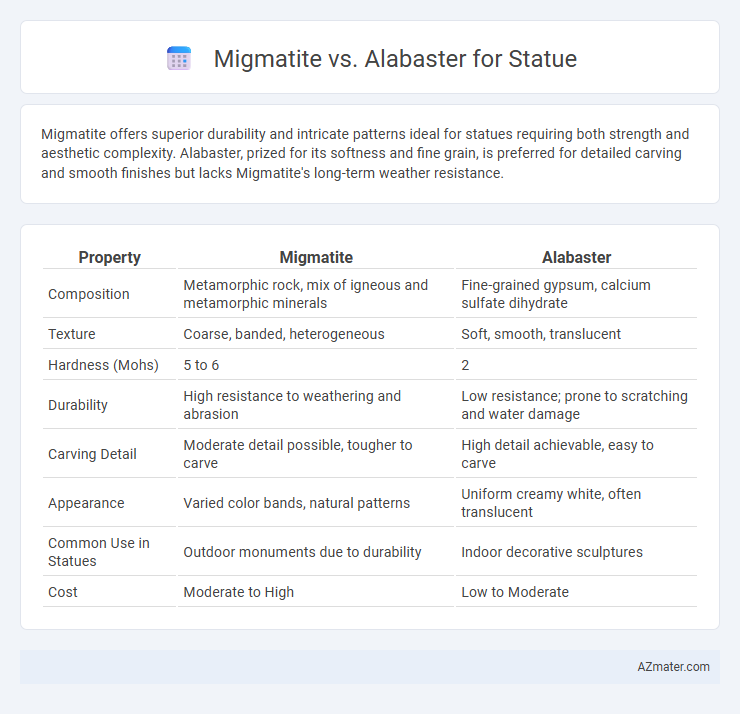Migmatite offers superior durability and intricate patterns ideal for statues requiring both strength and aesthetic complexity. Alabaster, prized for its softness and fine grain, is preferred for detailed carving and smooth finishes but lacks Migmatite's long-term weather resistance.
Table of Comparison
| Property | Migmatite | Alabaster |
|---|---|---|
| Composition | Metamorphic rock, mix of igneous and metamorphic minerals | Fine-grained gypsum, calcium sulfate dihydrate |
| Texture | Coarse, banded, heterogeneous | Soft, smooth, translucent |
| Hardness (Mohs) | 5 to 6 | 2 |
| Durability | High resistance to weathering and abrasion | Low resistance; prone to scratching and water damage |
| Carving Detail | Moderate detail possible, tougher to carve | High detail achievable, easy to carve |
| Appearance | Varied color bands, natural patterns | Uniform creamy white, often translucent |
| Common Use in Statues | Outdoor monuments due to durability | Indoor decorative sculptures |
| Cost | Moderate to High | Low to Moderate |
Understanding Migmatite: Formation and Properties
Migmatite forms through the partial melting of metamorphic rocks under high temperature and pressure conditions, resulting in a unique mixture of igneous and metamorphic characteristics. Its heterogeneous texture combines quartz, feldspar, and mica, providing exceptional durability and resistance to weathering, making it suitable for statues exposed to outdoor elements. These properties contrast with alabaster, which is softer and more prone to erosion, highlighting migmatite's advantage in sculptural applications requiring longevity.
Alabaster: Characteristics and Historical Significance
Alabaster is a fine-grained, translucent gypsum or calcite known for its smooth texture and ability to be intricately carved, making it ideal for detailed statues and sculptures. Its softness allows artisans to create delicate features, while its natural light diffusion enhances the visual appeal of finished works. Historically, alabaster has been prized since ancient Egypt and Mesopotamia for religious artifacts and burial items, symbolizing purity and protection across various cultures.
Appearance and Aesthetic Qualities Compared
Migmatite exhibits a striking, swirling pattern of light and dark mineral bands that create a dynamic, visually complex surface, offering statues a natural and earthy aesthetic. Alabaster, by contrast, features a smooth, translucent, and often creamy white appearance that provides a soft, luminous quality ideal for detailed carving and elegant finishes. The choice between migmatite's rugged, multicolored texture and alabaster's uniform, radiant surface depends on the desired visual impact and stylistic expression in sculptural art.
Workability: Sculpting with Migmatite vs Alabaster
Migmatite, with its mixed crystalline and metamorphic composition, is significantly harder and more resistant, making it challenging to carve intricate details compared to alabaster's soft, fine-grained texture. Alabaster's excellent workability allows sculptors to achieve smooth finishes and delicate shapes with basic tools, while migmatite requires specialized equipment and advanced techniques for shaping. Consequently, alabaster remains the preferred choice for detailed statues due to its ease of manipulation and smooth tactile quality.
Durability and Longevity of Statues
Migmatite offers superior durability for statues due to its mixed metamorphic and igneous composition, making it resistant to weathering and erosion over time. Alabaster, being a softer, fine-grained sedimentary material, is more prone to scratching and deterioration when exposed to moisture and environmental factors. Statues crafted from migmatite typically exhibit greater longevity and structural integrity compared to those made from alabaster, especially in outdoor settings.
Cost and Availability of Migmatite and Alabaster
Migmatite is generally more expensive than alabaster due to its rarity and complex extraction process, often limiting its availability to specific geological regions. Alabaster is widely accessible and more affordable, making it a popular choice for sculptors seeking cost-effective materials without sacrificing aesthetic appeal. The cost difference stems mainly from the abundant deposits of alabaster, while migmatite's unique composition and limited quarry locations drive up its price and reduce availability.
Best Uses: Ideal Applications in Sculpture
Migmatite offers exceptional durability and intricate veining, making it ideal for large-scale, outdoor sculptures requiring weather resistance and visual complexity. Alabaster is prized for its translucent quality and softness, perfect for finely detailed indoor statues and decorative art where smooth texture and subtle light diffusion are essential. Sculptors choose Migmatite for monumentality and rugged aesthetics, while Alabaster excels in creating delicate, luminous masterpieces.
Weather Resistance and Outdoor Suitability
Migmatite offers superior weather resistance and durability for outdoor statues due to its mixed metamorphic and igneous composition, which provides enhanced hardness and resistance to erosion and freezing conditions. Alabaster, being a soft and porous sedimentary rock primarily composed of gypsum or calcite, is much less suitable for outdoor use as it easily weathers, dissolves in rainwater, and suffers surface erosion under UV exposure. Statues intended for long-term outdoor display benefit from migmatite's resilience, while alabaster is best reserved for indoor sculptures protected from harsh environmental factors.
Notable Statues: Case Studies and Examples
Migmatite statues, such as those found in certain Himalayan art pieces, showcase intricate natural veining that enhances their aesthetic appeal and durability, making them ideal for outdoor monuments enduring weathering. Alabaster, exemplified by the "Lady in a Rock" sculpture at the Metropolitan Museum of Art, offers smooth, translucent qualities that allow for detailed carving and light diffusion, perfect for indoor displays. Both materials are favored in distinct contexts, with migmatite prized for robustness in monumental statuary and alabaster selected for finely detailed, luminous works.
Choosing the Right Stone: Migmatite or Alabaster?
Migmatite offers exceptional durability and unique banded patterns, making it ideal for large, outdoor statues that require weather resistance and structural strength. Alabaster provides a smooth, translucent surface well-suited for intricate carvings and indoor displays, highlighting fine details with its softness and light-transmitting qualities. Selecting between migmatite and alabaster depends on the statue's intended environment, desired texture, and longevity requirements.

Infographic: Migmatite vs Alabaster for Statue
 azmater.com
azmater.com